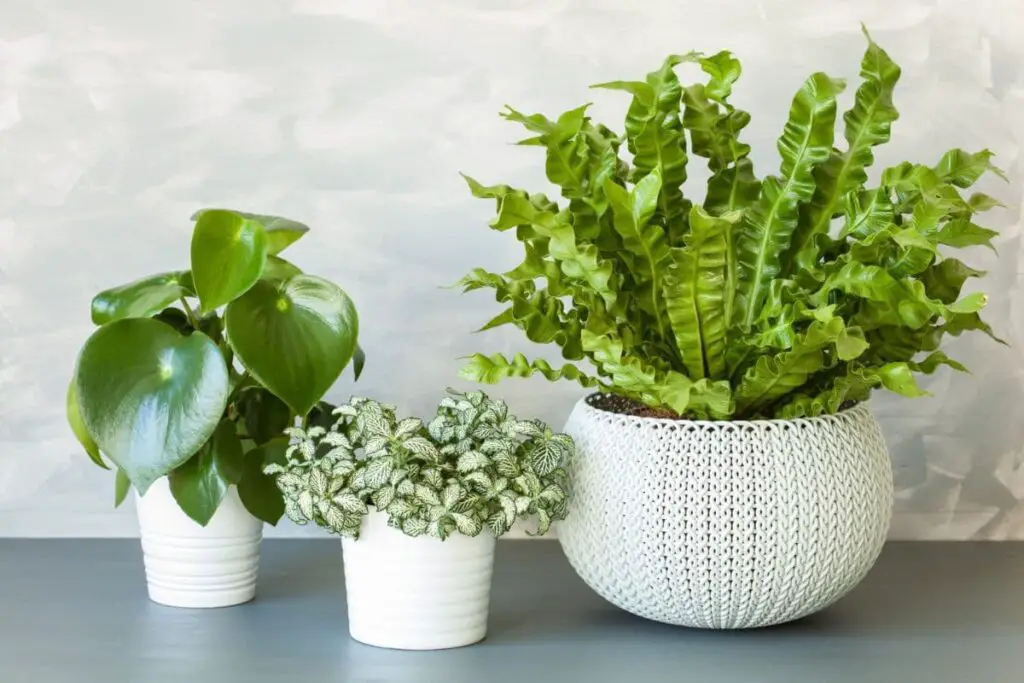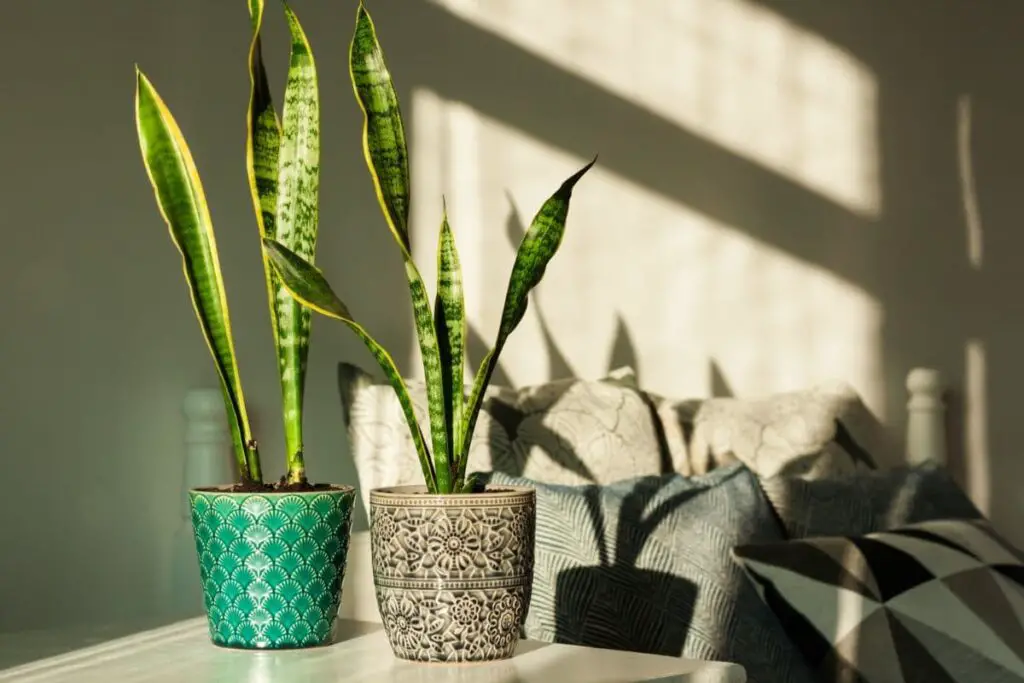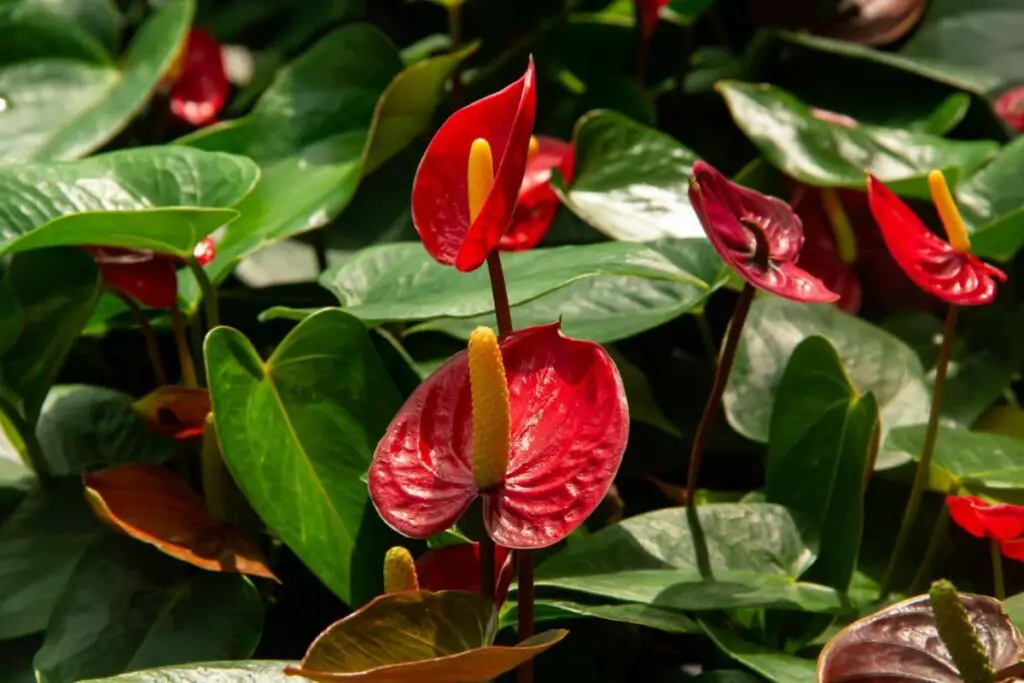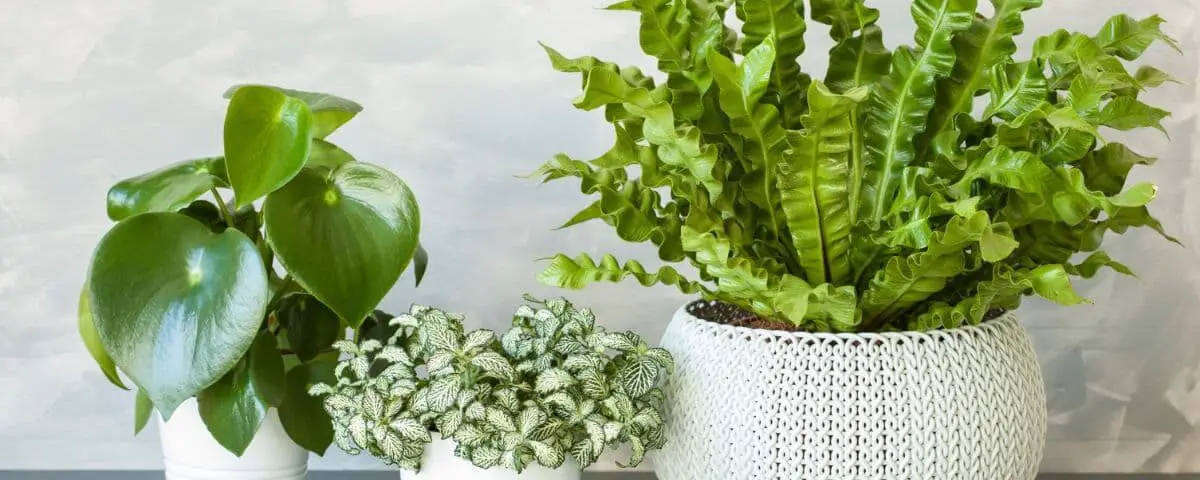|
Getting your Trinity Audio player ready...
|
Plants provide aesthetic appeal in homes but also purify the air we breathe. They use oxygen to create glucose and then convert the CO2 into oxygen before releasing it into the air. Knowing the best plants for CO2 absorption can help you improve the air quality in your home.
The best plants for CO2 absorption are the Snake Plant, Flamingo Lily, Bird’s Nest Fern, Bamboo Plant, Prayer Plant, Peace Lily, Aloe Plant, Pothos Plant, and Rubber Plant. During controlled studies, each of these plants has demonstrated its ability to reduce carbon dioxide levels in the air.
All the plants listed are available in most plant nurseries and are easy to grow and care for indoors. For the best air-purification benefits, place at least one plant per every 9 square metres (100 ft2).

1. Snake Plant (Sansevieria trifasciata)
Often referred to as “Mother-in-law’s tongue” for its sharpness, the snake plant is a hardy succulent native to Africa and India. It’s durable and can survive even the harshest conditions, which makes it an excellent choice for removing carbon dioxide indoors, especially for those without a green thumb.
The snake plant’s thick, striped leaves form in clusters and shoot upwards. Shoots may be short, broad, blunt, and triangle-shaped or long, skinny, pointy, and sword-like.
Different species feature different colours, patterns, and sizes.

Because Sansevieria trifasciata isn’t as dazzling or vibrant as other houseplants, it’s often overlooked. However, don’t ignore this unique plant, as it is excellent at removing indoor pollutants, including formaldehyde, benzene, and carbon monoxide.
It is also among the best plants for CO2 absorption.
According to a study published by Naresuan University, the snake plant absorbs carbon dioxide at 0.49 ppm per cubic metre. And it converts carbon dioxide to oxygen in low light levels, producing oxygen as you sleep.
To get the most out of snake plants, place one in every bedroom.
2. Flamingo Lily (Anthurium andraeanum)
Flamingo lilies are tropical evergreen perennials native to Ecuador and Colombia. As houseplants, these anthuriums are simple to care for, requiring only indirect light and thorough watering.

They don’t need regular fertilisation and can withstand a little neglect.
Anthuriums are popular because of their striking beauty. Their lustrous green leaves appear wax-like, almost fake, and their ornate flowers bloom in a range of vibrant hues. Though they can add charm to any room in a home, they do require adequate space, as they can grow up to one metre (3 feet) tall.
An article published in the civil engineering journal “MATEC Web of Conferences” states that anthuriums reduce CO2 at high rates. The amount of carbon dioxide the plant absorbs depends upon light intensity. The greater the light intensity, the more CO2 the anthurium collects. For example, at 700 lx, the plant reduced CO2 by 10.8%. At 300 lx, however, CO2 was only reduced by 2.2%.
These plants are attractive and offer more than just aesthetic appeal, as they are among the best plants for CO2 absorption.
3. Bird’s Nest Fern (Asplenium nidus)
The Bird’s Nest Fern is a tropical perennial native to the islands of Hawaii. It’s a great houseplant, as it’s easy to grow, provides plenty of greenery, and requires only indirect light, regular watering, and moderate humidity levels.
Bird’s nest fern isn’t the most gorgeous plant, and it will not elicit compliments whenever someone walks into your home, but it’s beautiful in its own way. It features broad, dramatic, deep green, glossy fronds that grow to a little over ½ metre tall.
When the fronds die off, organic material gathers in the centre, which supplies the plant with nutrients.
Though the Asplenium nidus doesn’t bloom, it does offer air purification benefits. The Horticulture Journal published a paper showing the Bird’s Nest Fern reduced CO2 to safe levels during a controlled experiment.
The plant also absorbed other harmful pollutants, including formaldehyde.
4. Bamboo Palm (Chamaedorea seifrizii)
Don’t let the name confuse you, as the Bamboo Palm isn’t actually bamboo at all. It’s a tropical palm that grows naturally in forest understories in Mexico and Central America. They’re also cultivated in the southern United States.
Chamaedorea seifrizii are well-suited for indoor growing. They survive just fine in low light and require intermittent watering to keep the soil slightly moist. Moderate humidity is a must, so occasional light mistings are recommended.
The Bamboo Palm’s exotic appearance adds a tropical vibe to any room. Their vibrant green fan or feather-shaped fronds look beautiful in well-lit bathrooms, bedrooms, or other living spaces. They are slow-growing and are usually kept as medium houseplants.
However, they can reach heights up to 3 ½ metres .
Chamaedorea seifrizii is one of the best plants for CO2 absorption. It removes carbon dioxide from the air and, in turn, releases oxygen making the air in your home fresh and clean. According to a two-year study conducted by the National Aeronautics and Space Administration (NASA), the Bamboo Palm also removes benzene, trichloroethylene, and formaldehyde.
5. Prayer Plant (Maranta leuconeura)
A tropical evergreen, the Prayer Plant is a popular houseplant native to Brazil. It requires indirect sunlight, high humidity, and thorough watering, with a period of slight drying in between. Though it has greater needs than other plants on this list, it’s still considered fairly easy to grow.
The Prayer plant presents showy egg-shaped leaves with curled edges that mimic hands folded in prayer, hence the name. Though the plant does bloom, its flowers are unremarkable. Instead, Maranta leuconeura is best known for its vibrant foliage, which features red, orange, or yellow striations and light-coloured undersides.
The MATEC Web of Conferences maintains that the Prayer Plant reduces CO2 levels in controlled studies. Reduction levels vary according to light intensity, with the highest reduction in carbon dioxide levels being 14.4% when exposed to a light intensity of 700 lx.
6. Peace Lily (Spathiphyllum wallisii)
The Peace Lily is a tropical flowering plant native to the American tropics and southeastern Asia. It received its name as its bracts look like white flags, an internationally recognised symbol for surrender.
These plants can seem dramatic because they wilt at the very first sign of needing water, but they actually tend to fare quite well as houseplants, even when neglected. They may not require much care, but they can do wonders for the indoor air quality in your home. This is why the Peace Lily is one of the best plants for CO2 absorption.
Spathiphyllum wallisii has thick, polished dark green leaves that rise from tall stems. When in bloom, Peace Lilies produce tall flowers protected by a silky white bract. Many mistake the white bract for the flower itself, though the flower is actually inside.
These lovely plants brighten any living space and are ideal for room corners because they don’t require bright sunlight.
There’s a correlation between the thickness of leaves and oxygen production, which explains why peace lilies are considered an ideal plant for air purification. According to the International Journal of Environmental Research and Public Health, these unassuming plants can lower indoor contaminant levels and significantly reduce carbon dioxide.
7. Aloe Plant (Aloe vera)
Aloe Plants are extremely common houseplants in the USA and Europe. These succulents are native to the hot, dry climates of Africa, Madagascar, and the Arabian Peninsula. They require very little in the way of care, preferring dry conditions and indirect light.
This plant is cactus-like in appearance, featuring long, thick, spear-like leaves with tiny, white spike-lined edges.
Leaves may appear pale green, grey-green, or light green in colour. Some appear solid, whereas others may have white or cream-coloured specks or splotches. Aloe vera plants can grow as tall as 1 metre. When flowering, they produce a tall spike (up to 90 centimetres) with bright yellow blooms.
Aloe is well-known for the gel in the leaves, used for its medicinal properties, and is often consumed or used on the skin to promote burn healing.
Additionally, the Aloe Plant is recognised for its air-purification benefits. It removes formaldehyde, benzene, and other pollutants and is regarded as one of the best plants for CO2 absorption. Like the snake plant, it releases oxygen at night, making it great for bedroom placement.
8. Pothos (Epipremnum pinnatum)
The Pothos plant (or Devil’s Ivy) is one of the most well-loved houseplants in the USA. This evergreen climber is native to Southeast Asia and parts of the Western Pacific, and when grown as a houseplant, it’s seen in hanging baskets.
The Pothos plant features vibrant green, lustrous, heart-shaped leaves. They’re often lined with yellow or pale-coloured veins or splotches. The leaves grow on long, spindly stems that hang down and can be up to one metre long.
Epipremnum pinnatum is remarkably efficient at removing indoor air pollutants, including xylene, formaldehyde, and carbon dioxide. In a six-hour period, one Pothos Plant removed 0.98 micrograms of carbon dioxide per square centimetre of its leaf surface.
Controlled studies have also proven that the plant effectively removes carbon monoxide from closed chambers.
This plant is also highly effective at absorbing carbon dioxide. So much so, in fact, that researchers at the University of Washington used Devil’s Ivy as part of a genetic modification study. They took a Pothos Plant and modified its genes to create a new type of Pothos plant that can also remove chloroform from the surrounding environment.
9. Rubber Plant (Ficus elastica)
Ficus elastica is a tree native to parts of South and Southeast Asia. It’s also become well-established in various other regions, including the West Indies and the American state of Florida.
Many people keep the Rubber Plant indoors as a medium houseplant, whereas others allow it to grow tall and showcase it as an indoor tree.
These tough plants have very thick, leather-like leaves that can grow up to 30.5 centimetres long. The leaves come in various colours, including deep reds and dark greens, and may have splotches or specks of yellow, white, pink, or a combination of the three.
According to a paper published in the Polish Journal of Environmental Studies, rubber plants can absorb significant amounts of toxic chemicals from the air, including carbon dioxide. The study concluded that Ficus elastica removed 2,216 ppm of carbon dioxide levels during the controlled experiment. This makes the Rubber Plant among the best plants for CO2 absorption.

